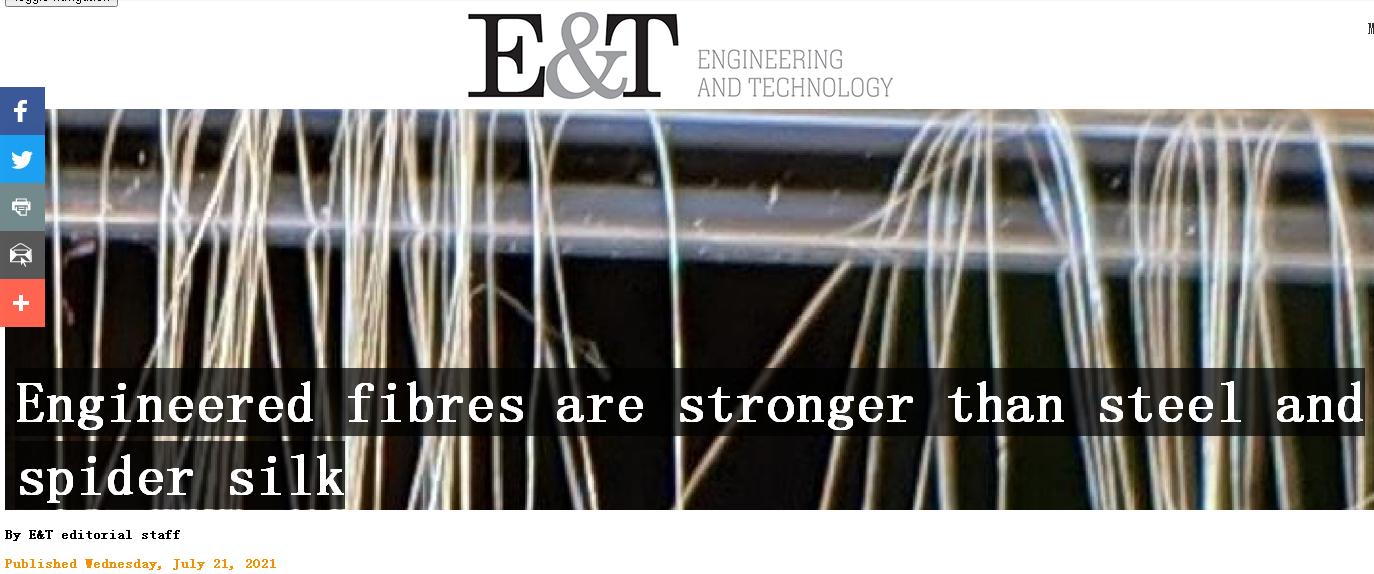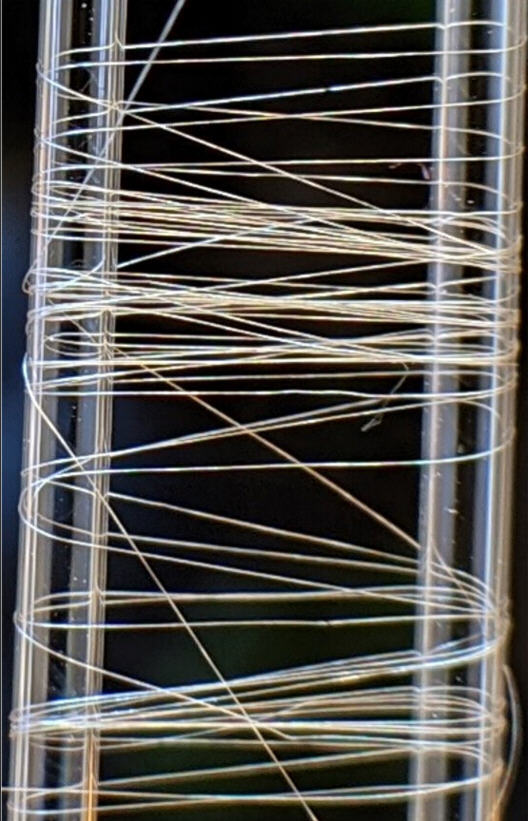博文
微生物产生的纤维:比钢更坚硬,比凯夫拉尔纤维更坚韧
 精选
精选
||
微生物产生的纤维:比钢更坚硬,比凯夫拉尔纤维更坚韧
诸平


Fig. 1 The 128-repeat proteins resulted in a fiber with gigapascal strength which is stronger than common steel. The fibers' toughness is higher than Kevlar and all previous recombinant silk fibers. Its strength and toughness are even higher than some reported natural spider silk fibers. Credit: Washington University in St. Louis/Jingyao Li

Fig. 2 This chart compares the toughness and strength of different natural and recombinant silk fibers. In red is the polymeric amyloid fiber developed in Fuzhong Zhang's lab. Credit: Washington University in St. Louis/Jingyao Li
据美国圣路易斯华盛顿大学(Washington University in St. Louis)2021年7月21日提供的消息,微生物产生的纤维:比钢更坚硬,比凯夫拉尔(Kevlar)纤维更坚韧。据说蜘蛛丝是地球上最坚韧的材料之一。但是现在,圣路易斯华盛顿大学的工程师们设计了淀粉样丝杂交蛋白(amyloid silk hybrid proteins),并用工程细菌生产它们。由此产生的纤维比一些天然的蜘蛛丝更坚韧。相关研究结果已经在《ACS Nano》杂志网站发表——Jingyao Li, Yaguang Zhu, Han Yu, Bin Dai, Young-Shin Jun, Fuzhong Zhang. Microbially Synthesized Polymeric Amyloid Fiber Promotes β-Nanocrystal Formation and Displays Gigapascal Tensile Strength. ACS Nano , 2021. DOI: 10.1021/acsnano.1c02944. https://pubs.acs.org/doi/10.1021/acsnano.1c02944
确切地说,这种被称为“多聚淀粉样”纤维("polymeric amyloid" fiber)的人造丝并不是由研究人员在技术上制造的,而是由麦凯维工程学院(McKelvey School of Engineering)能源、环境与化学工程系教授张福忠(Fuzhong Zhang音译)的实验室通过基因工程细菌制造的。
张福忠以前也做过蜘蛛丝(spider silk)研究。2018年,他的实验室改造了一种重组蜘蛛丝(recombinant spider silk),使其在所有重要机械性能上都能与天然蜘蛛丝媲美。
张福忠说:“在我们之前的研究之后,我想知道我们是否能利用我们的合成生物平台创造出比蜘蛛丝更好的东西。”
该研究团队,包括此论文的第一作者、张福忠实验室的博士生李景耀(Jingyao Li音译),修改了蜘蛛丝蛋白质的氨基酸序列,引入新的特性,同时保留了蜘蛛丝的一些吸引人的特征。
与重组蜘蛛丝纤维有关的一个问题——无需对天然蜘蛛丝序列进行重大修改——是需要制造β纳米晶体(β-nanocrystals),这是天然蜘蛛丝的主要成分,有助于增强其强度。
张福忠说:“蜘蛛已经找到了纺出合适数量纳米晶体纤维的方法。但当人类使用人工纺丝工艺时,合成丝纤维中的纳米晶体含量往往低于天然丝纤维。”
为了解决这个问题,研究小组通过引入淀粉样蛋白序列重新设计了蚕丝序列,淀粉样蛋白序列具有形成β-纳米晶体的高趋势。他们用三种已被充分研究过的淀粉样蛋白序列作为代表,创造了不同的聚合淀粉样蛋白。由此产生的蛋白质比蜘蛛丝具有更少的重复氨基酸序列,这使得它们更容易被工程细菌生产出来。最终,该细菌产生了一种含有128个重复单位的杂交聚合淀粉样蛋白。用相似重复单位重组蛛丝蛋白已被证明是困难的。
蛋白质越长,产生的纤维就越坚韧。这些重复128次的蛋白质产生了一种具有吉帕斯卡强度(gigapascal strength)的纤维,这种纤维比普通钢更强。这种纤维的韧性(衡量断裂一根纤维需要多少能量的指标)比凯夫拉尔(Kevlar)纤维和之前所有的重组丝纤维都要高。它的强度和韧性甚至比一些报道的天然蜘蛛丝纤维还要高。
在与能源、环境与化学工程系的Young- Shin Jun教授和她的博士生朱亚光(Yaguang Zhu音译)的合作下,该团队证实了聚合物淀粉样纤维的高机械性能确实来自于增加的β纳米晶体数量。
这些新的蛋白质和产生的纤维并不是张福忠实验室高性能合成纤维的结局。他们才刚刚开始。张福忠说:“这表明,我们可以通过工程生物学生产出比自然界最好的材料更好的材料。”
上述介绍仅供参考,欲了解更多信息敬请注意浏览原文或者相关报道。
The ability of amyloid proteins to form stable β-sheet nanofibrils has made them potential candidates for material innovation in nanotechnology. However, such a nanoscale feature has rarely translated into attractive macroscopic properties for mechanically demanding applications. Here, we present a strategy by fusing amyloid peptides with flexible linkers from spidroin; the resulting polymeric amyloid proteins can be biosynthesized using engineered microbes and wet-spun into macroscopic fibers. Using this strategy, fibers from three different amyloid groups were fabricated. Structural analyses unveil the presence of β-nanocrystals that resemble the cross-β structure of amyloid nanofibrils. These polymeric amyloid fibers have displayed strong and molecular-weight-dependent mechanical properties. Fibers made of a protein polymer containing 128 repeats of the FGAILSS sequence displayed an average ultimate tensile strength of 0.98 ± 0.08 GPa and an average toughness of 161 ± 26 MJ/m3, surpassing most recombinant protein fibers and even some natural spider silk fibers. The design strategy and the biosynthetic approach can be expanded to create numerous functional materials, and the macroscopic amyloid fibers will enable a wide range of mechanically demanding applications.
https://blog.sciencenet.cn/blog-212210-1296466.html
上一篇:母乳喂养的避孕效果随社会经济发展而降低
下一篇:RNA的突破创造了可多产50%的土豆和水稻